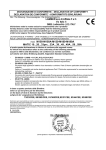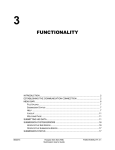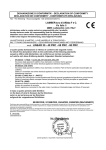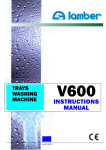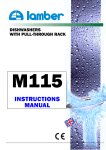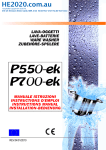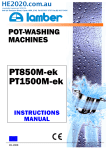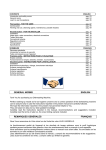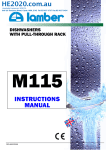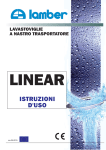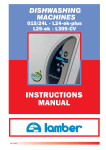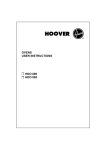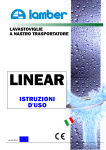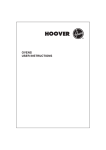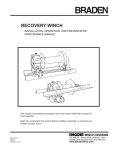Download Product Information Sheet 1
Transcript
HE2020.com.au Hospitality Equipment 2020 P/L Unit 6/6 Tennyson Street, Clyde, NSW, 2142 Tel.02 9637 3737 Fax.02 9637 3434 DISHWASHERS WITH PULL-THROUGH RACK MATIC M-MA INSTRUCTIONS MANUAL R01-05-2008 HE2020.com.au Unit 6/6 Tennyson Street, Clyde, NSW, 2142 Tel.02 9637 3737 Fax.02 9637 3434 [email protected] DECLARATION OF CONFORMITY The following hereby declares under full responsability that the following product RACK CONVEYOR DISHWASHERS mod. M115/ASM-130-M150-M150A-M180-M180A MATIC 10...20...33prc...33A...39...49...49A...59...59A MA10-MA20-MA33-MA39-MA49-MA59 for which this declaration refers to the conformity of the following standards: • • • • • • • • • • • • • • • • • Safety of household and electrical appliances - General requirements EN60335-1(2002) + A1/A11(2004), A12 (2006) + A2 (2006) Safety of household and electrical appliances - Part 2^ Particular requirements for commercial electric dishwashing machines EN60335-2-58 (2005) Household and similar electrical appliances EN50366(2003) +A1(2006) – Electromagnetic fields – Methods for evaluation and measurements Limits and methods of measurement of radio disturbance characteristics of electrical motor-operated and thermal appliances for households and similar purposes, electric tools and similar electric apparatus - EN 55014-1(2000) + A1(2001) + A2(2002) Limits for harmonic current emissions (equipment input current ≤ 16 A per phase) - EN 61000-3-2(2000) + A2 (2005) Limitation of voltage fluctuations and flicker in low-voltage supply systems for equipment with rated current ≤ 16 A. EN 610003-3(1995) +A1(2001) + A2(2005) Immunity requirements for household appliances, tools and similar apparatus. Product family standard EN 55014-2(1997) + A1(2001) Safety of machinery Basic concepts, general principles for design - Basic terminology, methodology-ISO 12100-1 (2003). Safety of machinery - Basic concepts, general principles for design - Technical principles-ISO 12100-2 (2003). on the basis of what is foreseen by the Directives: 2006/95/CE, 2004/108/CE, 2006/42/CE. 2006/95/EC, 2004/108/EC, 2006/42/EC. We decline any responsability for injuries or damage derived from machine misuse, abuse by others or improper machine maintenance or repairs. li 01/01/08 (date) The administrator HE2020.com.au Unit 6/6 Tennyson Street, Clyde, NSW, 2142 Tel.02 9637 3737 Fax.02 9637 3434 [email protected] MODEL SCHEDADESMATIC/c dr MODEL PRE-WASHING RINSING FIRST WASHING PRE-RINSING+RINSING SECOND WASHING THIRD WASHING HE2020.com.au Unit 6/6 Tennyson Street, Clyde, NSW, 2142 Tel.02 9637 3737 Fax.02 9637 3434 [email protected] TECHNICAL DATA AND DESCRIPTION The table reported at page 3 shows the basic models of conveyor dishwashers and identifies the single washing areas to which additional modules can be added to improve their performance. ACCESSORIES COLD PRE-WASHING STEAM CONDENSER - CVM DRYING – ASM - MVM ADDITIONAL RINSING - RIS HEAT RECOVERER – RC-CVM AUTOTIMER SPLASH SHIELD (PMC-PMA-PMA/R) BOOSTER PUMP fan fan kW kW fan kW Motor kW CVCP HEAT PUMP Heat element kW kW TECHNICAL SPECIFICATIONS Model: version 1st speed MATR. Left-Right Right-Left 2nd speed baskets/hour ELECTRIC POWER baskets/hour kW ELECTRICAL INPUT A ELECTRIC CABLE mm2 CIRCUIT BREAKER A lcc ELECTRIC INPUT 6 kA VOLTAGE PRE-WASHING TANK ELEMENTS kW ELECTRIC PUMP kW FIRST WASHING TANK ELEMENTS kW ELECTRIC PUMP kW SECOND WASHING TANK ELEMENTS kW ELECTRIC PUMP kW THIRD WASHING TANK ELEMENTS kW ELECTRIC PUMP kW PRE-RINSING TANK ELEMENTS kW ELECTRIC PUMP kW RINSING BOILER ELEMENT kW BOILER ELEMENT kW GEARED MOTOR kW 4 HE2020.com.au Unit 6/6 Tennyson Street, Clyde, NSW, 2142 Tel.02 9637 3737 Fax.02 9637 3434 [email protected] GEARED MOTOR kW Contents General norms Introduction and safety norms Unpacking and delivery checks page page page 06 07 09 1 – INSTRUCTIONS FOR THE USER page 10 First section - For the user – Operation before washing page 11 Switch-on and use of the dishwashing machine mod. M130-M150-M180-MATIC 10, MATIC 20-33prc MATIC 39-49-59, MA10-20-33-39-49-59 page 13 Symbols used for the controls page 16 Washing of dishes – During washing operations After washing operations page page 17 19 Helpful suggestions - Achievements Safety devices page page 21 21 Washing flow control system page 23 Useful hints of stainless steel maintenance page 24 2 – INSTRUCTIONS FOR THE INSTALLER page 25 Installation page 26 Second section - For the installer – Detergents page 27 Disposal page 28 Positioning – Electrical connection page 29 Water connections page 30 Water draining - Steam feeding – Steam exhaust page 31 Vapours suction - Testing – Working temperatures page 32 Torque limiter page 33 Steam condenser page 34 Eventual drawbacks –causes - remedies page 35 Modification of parameter’s programming page 39 Table connection scheme page 45 Wiring diagram page 46 5 HE2020.com.au Unit 6/6 Tennyson Street, Clyde, NSW, 2142 Tel.02 9637 3737 Fax.02 9637 3434 [email protected] INSTRUCTIONS MANUAL DISHWASHING MACHINES MATIC-M-MA The automatic-rack conveyor dishwashing machines of the designed to wash any kinds of dishes . MATIC -M-MA series are The modular system and the various optionals available allow the make-up of dishwashing machines with the most appropriate features in order to meet your production,space saving and energy-saving requirements. GENERAL NORMS ENGLISH Tank You for purchasing our Dishwashing Machine. Perfect washing-up results as far as hygiene concerns and a correct operation of the dishwashing machine can be assured only in case the instructions reported in the present manual are carefully followed. We hope the information reported in the present manual will be helpful to You. They are based on data and our best updated knowledge. Carefully read the Instructions reported in the manual, recommendations and suggestions included. Carefully read the terms of sale too, the ones limiting warranty included. 6 HE2020.com.au Unit 6/6 Tennyson Street, Clyde, NSW, 2142 Tel.02 9637 3737 Fax.02 9637 3434 [email protected] INTRODUCTION AND SAFETY NORMS INTRODUCTION This equipment is destined only to the use it has been conceived for: tableware washing such as dishes, glasses, cups, cutlery, trays, etc. Using it to wash machine components or objects whose dimensions are superior to the machine working passage is improper and therefore dangerous. - Equipment in compliance with EEC89/336 directive concerning the suppression of radio interferences and electromagnetic incompatibility. - In conformity with the EEC directives and the fulfilment laws, our dishwashers are built according to the regulations in force in Italy and abroad. - The noise of the machine running empty, measured at the working positions (fig. 1) and at 1.6m from the floor, is the following: Leq A Level equivalent of sound pressure dB(A) position 1 position 2 position 3 70 68 70 The level of peak sound pressure Lpc is not declared as it is much inferior to 130dB(C): PRELIMINARY OBSERVATION Carefully read the instructions reported in the present user manual, as it gives important indications about safety of installation, operation and maintenance: carefully keep the present manual for further consultations; the illustrations and drawings showing the machine are intended for general reference only and are not necessarily accurate in every particular; - the dimensions and characteristics of the machine, given in this Manual, are not to be considered binding and may be changed without prior notice; - having removed the packing material, check that all the equipment is present. If there is any doubt, do not use it and contact qualified personnel. The packing elements (plastic bags, nails, etc.) should be kept away from children, because they are dangerous. 7 HE2020.com.au Unit 6/6 Tennyson Street, Clyde, NSW, 2142 Tel.02 9637 3737 Fax.02 9637 3434 [email protected] GENERAL SAFETY REGULATIONS THIS SAFETY CODE HAS BEEN COMPILED IN YOUR INTEREST. Strict adherence to these rules will reduce the risks of injury both to yourself and to others; Personnel working with this machine must adhere strictly to all statutory safety regulations as well as the specific rules listed below. Failure to do so may result in personal inyury and damage to the machine; DO NOT attempt to move, install, set-up or operate this machine until you have read and fully understood this Manual. If doubt persists, ask your supervisor; never leave tools, parts or other loose material on or in the machine; Before switching the equipment the equipment on, make sure that the model plate data conforms to that of the electrical and water distribution network; remember that even with the mains isolator in the “OFF” position, the incoming cables are still live; BEFORE starting machine o cycle, after any maintenance or repair work, make sure all protective are correctly installed; be vigilant at all times, remember that your safety and that of your fellow workers depend on you; when moving or lifting the machine, care must be taken to comply with all the relevant regulations governing such operations; installation should be carried out by qualified personnel according to the manufacturer's instructions. this equipment should be destined to the use which it has been conceived for. Any other application should be considered improper and consequently dangerous; the equipment should only be used by personnel trained for its use; SPECIAL SAFETY REGULATIONS - adjustement and repairs must be carried out only by personnel qualified. Repair carried out by unskilled personnel may be dangerous; perfect washing-up results as far as hygiene concerns and a correct operation of the washing machine can be assured only in case the instructions reported in the present handbook are carefully followed; the machine must be only used by authorized personnel which must comply with sanitary measures; do not leave the machine in environment with temperatures inferior to 0°C; the machine protection degree is IP55 for Control board and IP32 for machine, therefore it should not be washed with direct high pressure jets of water; 8 HE2020.com.au Unit 6/6 Tennyson Street, Clyde, NSW, 2142 Tel.02 9637 3737 Fax.02 9637 3434 [email protected] UNPACKING AND DELIVERY CHECKS When the case with the machine has been received, unpack it as follows: - Remove the upper cover and the wooden case side walls, take care not to damage the machine, Remove possible accessories boxes, Remove the protecting cellophane, Make sure that the machine has not been damaged during transport, Make sure that all covers and panels have been correctly fixed and that no loosen part is present, Visually inspect that all electrical components are integral. TRANSPORT AND INSTALLATION - To lift and transport the machine, insert the truck forks under the frame connected to the points indicated by the yellow adhesives applied on the machine front side (see draw below). draw “A”* - - Before plugging the machine, make sure that the supply voltage of the domestic wiring system and the water supply from water connection corresponds to the ones reported on the rating plate Installation should be carried out by qualified personnel according to the manufacturer's indications During instalation, it is recommended to level the machine in order to ensure a correct operation. 9 HE2020.com.au Unit 6/6 Tennyson Street, Clyde, NSW, 2142 Tel.02 9637 3737 Fax.02 9637 3434 [email protected] INSTRUCTIONS FOR THE USER 10 HE2020.com.au Unit 6/6 Tennyson Street, Clyde, NSW, 2142 Tel.02 9637 3737 Fax.02 9637 3434 [email protected] MATIC-M-MA First Section - FOR THE USER OPERAT ION BEFORE WORKING BEFORE STARTING THE WORKING OPERATION BE SURE THAT: - the wall-mounted on/off switch is switched on; - the water and steam* cocks are open; - water and steam (*) are present in the system; - the filters are in their housings - curtains are correctly positioned; - the inspection doors are closed; - the dimensions of the dishes to be washed do not exceed the washing working dimensions; - Check that the detergent and rinse aid containers are not empty. - Switch the machine on . Go to the page dealing with the model selected . (*) for steam machines only DETERGENTS In case the machine is not provided with an automatic dispenser, pour the detergent directly into the washing tank and uniformly distribute it on the filters in the doses indicated by the supplier. N.B.: If you make use of chlorinated sanitizers, it is always advisable the employment of an automatic dispenser with feeler for the measurement of the detergent concentration, because brownish spots can form on the surfaces due to chlorine reactions when pouring the detergent directly into the tank. In any case the product shall be introduced near the pump suction pipe in the tank and at least 15 cm far from the bottom in order to avoid corrosion. Choice of the suitable cleansing agent is an essential condition if you want to obtain extremely good washing results as concerns hygienic results. It is then important to consider some points. First of all only highly alkaline and chlorine-active antifoam products, especially made for industrial dish-washing machines, must be used and they must be produced by well known reliable Firms. We provide a short list just as an indication: Ecolab-Soilax; Henkel; Lever; Diversey; Relativ. Mean concentration of the powder cleansing agents must be 1,5-2,5 g/lt. Mean concentration of liquid cleansing agents must be 2-4 g/lt. In order to avoid scales and corrosions, put cleansing agent above water level on the nearest area of the sucking pump filter, in this way it will immediately dilute and will not deposit on the tank bottom. 11 HE2020.com.au Unit 6/6 Tennyson Street, Clyde, NSW, 2142 Tel.02 9637 3737 Fax.02 9637 3434 [email protected] DESCALING When hard water is used you can find, inside the machine and also on objects, calcareous sediments which must be removed both for hygienic and operating reasons by a descaling operation. Operating process and frequency of this intervention are suggested by your cleansing agent supplier who has suitable products, generally containing phosphoric acid. In order to avoid damage to the machine do not increase the quantities and once operations end rinse abundantly. HYGIENE At last each 30 days it would be useful to do this operation which guarantees the complete hygienic conditions of the machine. We suggest to contact your cleansing agent supplier who will give you quantity and name of the most suitable product you can use and that, generally, is an active chloride powder (100-200 ppm). In order to avoid damage to the machine do not increase the quantities and once operations end, rinse abundantly. 12 HE2020.com.au Unit 6/6 Tennyson Street, Clyde, NSW, 2142 Tel.02 9637 3737 Fax.02 9637 3434 [email protected] ELECTRONIC DISHWASHER STARTUP AND USE L M N P O A R Q B C1 C2 1 1 2 7 3 4 5 6 7 F V H G E D pos.8 : option. Turn the voltage on by pushing the main button located on the control panel. The thermometer display C1, C2 lights up. Then follow the instructions: 1) Push the line button "A". Display information “V” will light up (ON LEVEL) and automatically start the tank loading (lamp “B” is blinking). When lamp "B" turning on indicates that the appropriate level has been reached in the tank and the heater element has been activated (the display visualizes MACHINE READY). Wait until the washing and rinsing temperatures reach respectively 55°C to 60°C and 80°C to 85°C. Check the temperature of thermometers. The display C1 indicates the number of the probe connected to the temperature indicated on display C2. 3) Then push button “D” (led on). The machine is ready to wash the dishes (the information display visualizes now WASHING ENABLED). 4) Select the conveyor speed according to the objects to wash, and push button “E” (led “F” corresponding to the selected speed will light up). 5) Push the START button “G” to start the washing and to move the racks (the display information visualizes now IN CYCLE). 6) Introduce the rack in the tunnel and follow the warning instructions indicated on paragraph “washing instructions” (see pag. 17). 7) The rinsing operation starts automatically at the passage of the 2) pos.1 : water inlet temperature; pos.2 : washing temperature; pos.3 : rinsing temperature; pos.4 : pre-wash temperature; pos.5 : pre-rinse temperature; pos.6 : drying temperature; pos.7 : second washing temperature. 13 HE2020.com.au Unit 6/6 Tennyson Street, Clyde, NSW, 2142 Tel.02 9637 3737 Fax.02 9637 3434 [email protected] dishes (led “N” lights up) (the display visualizes now IN RINSING CYCLE). If the lamp does not blink there is a problem at the rinsing electrovalve (call a qualified thechnician). 8) Should it be required to stop the washing operations, push button ”H” to stop the rack from moving. 9) To stop temporarily the rack basket from moving and to interrupt the washing, push the button “D” on OFF position (led off). The other heather elements stay ON (Standby position). 10) To turn off the Diswasher, push the button “A” (led “A” off). Optional Devices: If the machine is equipped with a Drying tunnel it is possible to activate the function of this optional device by pushing the button “O” (led on); If the machine is equipped with a pre-rinsing device, it is possible to activate the function of this optional by pushing the button “P” (led on); If the machine is equipped with a heat pump, it is possible to activate the function of this optional by pushing the button “Q” (led on). WASHING AUTOTIMER (optional) Thanks to the AUTOTIMER device it is possible to reduce water and power consumption when the machine is not used. To activate this function, push the button “R” (led on). Checking Device: The display “V” is blinking and visualizes the writing “Door open”, it indicates that one of the door was not closed correctly. Close the door again. HEAT PUMP (optional) The display “V” is blinking and visualizes the writing “Roller conveyor stop activated”, take out the basket at roller conveyor stop. The system exploits the heat produced in the cooling cycle, which allows to constantly regenerate energy from the hot air produced in the machine, to preheat the rinsing water. This device allows to feed the machine with cold water, so as to save a lot of energy ( al least 15,5 Kw). The display “V” is blinking and visualizes the writing “motor Alarm!”, it means that there is a problem at the overload cutout indicator. Call a qualified thechnician. FLOWMETER RINSING (optional) It checks the water flow is enough for a good final rinsing cycle. The blinking led “M” indicates a possible failure. During the normal operation of the Dishwasher the display ”V” will help you to understand which operation the machine is performing. The display “V” is blinking and visualizes the writing “CALL SERVICE!”. The display inform that the maintenance is necessary. The SERVICE function allows to program the maintenance interventions that have to be done on the machine, according to the kind of use. Call a qualified thechnician. 14 HE2020.com.au Unit 6/6 Tennyson Street, Clyde, NSW, 2142 Tel.02 9637 3737 Fax.02 9637 3434 [email protected] PREWASHING CORNER TUNNEL (optional) If a PRE-WASH CORNER TUNNEL is installed, the machine indicates when it is possible to insert the basket into the corner tunnel. The led “L” .marked with the symbol ( ) lights up when there is a basket inside the corner tunnel. Once the transport slide has been completed and the tunnel is free, the led “L” goes off: this indicates that it is possible to insert another basket. "Attention! This unit cannot be connected to any automatic basket loading system. Baskets can be introduced only by hand and by an operator.". 15 HE2020.com.au Unit 6/6 Tennyson Street, Clyde, NSW, 2142 Tel.02 9637 3737 Fax.02 9637 3434 [email protected] SYMBOLS USED FOR THE CONTROLS A MAIN ON/OFF SWITCH and MACHINE LOADING L CORNER LOADING ON B MACHINE ON LAMP M FLOWMETER C1 DISPLAY TEMPERATURE NUMBERS N RINSING ON C2 TEMPERATURE DISPLAY O DRYING ON P PRE-RINSING ON Q HEAT PUMP R TIMED WASHING, FOR MACHINES WITH AUTOTIMER CONTINUOUS WASHING D SPEED BUTTON E G START PUSHBUTTON H STOP PUSHBUTTON WATER INLET THERMOMETR WASH THERMOMETER RINSING THERMOMETER PRE-WASH THERMOMETER PRE-RINSING THERMOMETER TENTS POSITION DRYING THERMOMETER SECOND WASHING THERMOMETER QUMA-EK-SIMB-GBR OPTIONAL 16 HE2020.com.au Unit 6/6 Tennyson Street, Clyde, NSW, 2142 Tel.02 9637 3737 Fax.02 9637 3434 [email protected] 4) Avoid dipping your naked hands into the soapy hot water present in the tanks. This can cause burns and skin irritations. In this case, immediately rinse them with plenty of water. WASHING OF DISHES 1) Fisrt of all, remove any food residues and any oily masses . 2) Knives , forks and spoons should be previously softened; the same applies to dishes, should they be washed a long time after their use . 5) When the machine is working, do not open the inspection doors too quickly. 6) In case the conveyor belt is stopped by the safety device (limit switch), stop the machine by means of the red emergency mushroom pushbutton located near the operator before removing the obstacle causing the trouble. 3) Arrange the dishes as shown in the figures (page 18) . 4) Push the rack toward the inlet of the machine. The feeding system will make it step up automatically . (N.B. Insert the shelves so that dishes are faced to the inlet and trays are parallel to the machine). 7) Deactivate the equipment in case of fault or malfunction. For repairs, only address to a technical assistance center authorised by the manufacturer and impose the use of original spare parts. 5) If the operator is not in a position to remove the shelves from the outlet bracket, they, upon reaching the end thereof, would cause the feeding system and rinsing to stop. In order to restore the operating conditions, it is sufficient to remove that shelf that operates limit switch micro . The non-observance of the above could compromise the safety of the appliance and of the operators. For possible troubles occurring during the working cycles, see the relevant chapter. DURING WASHING OPERATIONS 1) Check that the water temperatures are in accordance with the specified values . 2) Monitor the levels of the detergent and the rinse agent liquid in the respective containers . 3) Remove the pre-wash filters periodically and remove any residues therefrom; it is suggested to buy another spare filter in order not to have to stop the machine for an extented period of time . 17 HE2020.com.au Unit 6/6 Tennyson Street, Clyde, NSW, 2142 Tel.02 9637 3737 Fax.02 9637 3434 [email protected] BASKETS CB PP12/18 CVA (option) G8 cestelli-matic/cdr 18 HE2020.com.au Unit 6/6 Tennyson Street, Clyde, NSW, 2142 Tel.02 9637 3737 Fax.02 9637 3434 [email protected] 3 - IMPORTANT: Before carrying-out the cleaning and maintenance operations, disconnect the equipment from the mains voltage through the wall-mounted on/off switch and close the water and steam* supply cocks; AFTER WASHING OPERATIONS PRECAUTION INSTRUCTIONS - - AND CLEANING high temperatures can be reached inside the machine (90°C). Affter power supply has been removed, wait until the machine has reached the room temperature, before working on it; never leave tools, parts or other loose material on or in the machine; BEFORE starting machine or cycle, after any maintenance or repair work, make sure all protective are correctly installed; 4- . 5- Wash the inside of the machine with a water jet. 6– When everything is clean and water is completely drained, take out and clean carefully the flat filters the suction pump filters (draw 4 – n.2-4) and that of the pre-wash (if any-draw 5 – n.1) and wash them carefully every day (don't beat them against the floor or others) . 7– Remove and wash the splash-guard curtains. 8- For machines with steam condensation only, remove the steam aspiration filter (fig.6) end clean it. At the end of the working operations: 1 – Push the STOP button “H” and push the button "A" to switch off the machine. Attention! For machines with Drying system it is necessary to wait 5 minutes before pushing the button "A" to switch off the machine; This make Fan able to cool elements. Lift the inspection doors making sure that they are firmly linked to the apposite support. Tank drain by drain valve It is necessary to push the button “D” at the end of the working process for 3 seconds: -The LED will flash and on the information display you will read “TANK DRAIN” (attention! The “A” button has to be on switch-off position). -After two minutes the drain stops automatically. fig.6 – Steam condenser 9- 2 - Take off the machine by means the disconnecting switch located on the control panel. 19 Check that the washing nozzles are not clogged. If necessary, disassemble the nozzles and pay attention to assemble them again in the right position (twice a week) . HE2020.com.au Unit 6/6 Tennyson Street, Clyde, NSW, 2142 Tel.02 9637 3737 Fax.02 9637 3434 [email protected] 10 - Remove the rinsing arms by rotating them counter-clockwise and check that the nozzles are not clogged: if otherwise, clean them using a needle (every week). 11 - Replace the filters taking care that: Curtains shall have their shortest side turned towards the basket inlet (see the blue signalling marks located on the doors) 12 - Clean the outside part of the machine using a wet sponge .Don't use water jets that, beside being dangerous, could also damage the electrical parts. Don't use detersive, abrasives, steel-wools or steel-brushes. 13 – In order to avoid the formation of nasty smells, let the doors open making sure that they are firmly linked to the apposite supports. * for steam machines only Machine prolonged stop In case the machine is not used for some weeks it is advisable to carry out an accurate cleaning of all components inside to avoid the formation of unpleasant smells. In case of a very long standstill, it is advisable to oil the stainless steel surfaces with white mineral oil. 20 HE2020.com.au Unit 6/6 Tennyson Street, Clyde, NSW, 2142 Tel.02 9637 3737 Fax.02 9637 3434 [email protected] IMPORTANT: Before carrying out cleaning and maintenance operations disconnect the machine from the power supply source by means of the wall-mounted switch or by means of the disconnecting switch located on the control panel. • pre-washing temperatur is 40 °C maximum; • washing temperature is from 55 to 60 °C, • rinsing temperature is from 80 to 85 °C, • there is detergent in the right concentration; • the filters are clean; • washing water is not dirty; • the positions of the objects in the rack are correct. WARNING! - Do not disconnect the switch when the machine is on! SAFETY DEVICES HELPFUL SUGGESTIONS MAINTENANCE Check and frequently clean the nozzles. The frequency at which such operation shall be carried out will be suggested by the quantity of residues and scales and by the unsatisfying washing results. The dishwashers are equipped with a number of devices in order to ensure the safety of the operator and of the appliance itself. LIMIT MICROSWITCH To clean the machine outside and inside, never make use of corrosive products such as sodium hypochlorite (bleach) and hydrochloric acid (muriatic acid), acids in general, wire wool and steel brushes. If dishes reach the end of the unloading area, before the operator has managed to unload the basket, the limit switch stops the drawbar motion and therefore the baskets. To avoid compromising the correct operation and to keep the appliance in optimal hygienic conditions, it is advisable to carry out periodical sanifications and scale removing operations. DOOR MICROSWITCHES Each inspection door is provided with two safety microswitches forming two redundant chains (safety level 2). If one of the doors is opened accidentally, the pumps, the conveyor belt gearmotor and the rinsing area solenoid valve stop working. This way all washing operations are stopped preventing dangerous jets of hot water from spurting out. Operation is restored only when the door are closed again and the start button “H” pressed. In case of appliances with more complex layouts, more pushbuttons near the operator can be necessary. ACHIEVEMENTS Any deficiency in the washing process is apparent when dirty residuals are visible. Any halos might be caused by an insufficuent rinsing: in this case, check that the rinsing jets are clean and there is a sufficient pressure in the water distribution network (2÷4 bar) ; In the case that residuals are present, check that: • the washing jets are clean 21 HE2020.com.au Unit 6/6 Tennyson Street, Clyde, NSW, 2142 Tel.02 9637 3737 Fax.02 9637 3434 [email protected] EMERGENCY STOP PUSHBUTTON ELEMENTS PROTECTION Dish inlet and outlet side of the machine is equipped with a red mushroom-shaped pushbutton on yellow field, which, if pressed, stops all motors. Once the trouble has been removed, it is possible to restart the machine only after the pushbutton has been rotated and released. Subsequently press the start button “H” again. More pushbuttons may be necessary near the operators depending upon the appliance washing characteristics. Each element is protected against short circuit by automatic breakers. Tank elements are protected against dry running by minimum level pressure switch. Boiler and dryer elements by thermostats with manual reset. In case of troubles, ask for the intervention of qualified and authorized personnel (see the paragraph dedicated to the user). TORQUE LIMITER Although the appliance is equipped with the above-mentioned safety devices, danger of burns to upper limbs persists. RESIDUAL RISKS The drawbar forward feeding system is provided with a mechanical friction torque limiter located in the drawbar system. Each time something interposes between the basket and the machine or the central drawbar is overloaded, the bar motion lowers rapidly to zero. In this case it is necessary to switch the machine off by means of stop or emergency pushbuttons, remove the obstacle and press the start button again. To calibrate this kind of device, see the relevant chapter included in the second part of the manual dedicated to the installer. As already mentioned in the paragraph “DURING WASHING OPERATIONS”, avoid dipping your naked hands into soapy hot water of the tanks. This can cause burns and skin irritations. In this case, immediately rinse them with plenty of water.Anyway consult the product card of the detergent employed. MOTOR PROTECTION DEVICES Each motor is protected against shortcircuits and current overload by automatic magneto-thermal relays. Lamp "M" switching on signalizes the intervention of any of these relays. In this case, the machine should be switched off and qualified personnel should be asked for repair. 22 HE2020.com.au Unit 6/6 Tennyson Street, Clyde, NSW, 2142 Tel.02 9637 3737 Fax.02 9637 3434 [email protected] WASHING FLOW CONTROL SYSTEM pos. “2” pos. “1” Highest power (position 1) Lowest power (position 2) The flow control system is a device that allows You to act on the intensity of the washing power. This can be useful by washing glasses, when it is necessary to reduce the washing jet power. This device is placed into the pre-washing and washing areas of the rack conveyor dishwashing machines, by the lower washing arms group. In order to act on the control system You have to rotate the lever “A” by hand anticlockwise to rise the washing jet power and clockwise to reduce it. If You turn it thoroughly leftwards, You get the highest power (pos.1). If You turn it thoroughly rightwards, You get the lowest power (pos.2). 23 HE2020.com.au Unit 6/6 Tennyson Street, Clyde, NSW, 2142 Tel.02 9637 3737 Fax.02 9637 3434 [email protected] USEFUL HINTS OF STAINLESS STEEL MAINTENANCE Stainless steel is so called because it is not affected by oxidation,this is due to a thin molecular layer of oxide on the surface which protects againts further oxidation. There are, howevwr, substances which can modify or destroy this layer,giving rise to corrosion:besides preventing the protective film of oxide from reforming,these substances corrode the stainless steel itself and can cause irreparable damage. It is therefore necessary to prevent this by choosing correct cleaning products and by complying with the following simple recommendations:never forget that when using these appliances,the first and fundamental rule is to guarantee that the cleaning products are both non-toxic and hygienic. Before using any detergent to clean either the stainless steel or the immediate and sorrounding floor area, always ask your supplier for the most suitable product which does not cause corrosion on the steel itself; the onset of rust is most commonly caused by the use of unsuitable cleaning materials (strongly acid chlorate based detergents) or on inadequate maintenance. Our appliances are made of stainless steel AISI 304 (18-10 type) for exterior panelling,upper tops,tanks etc. Comply with the following instructions when cleaning and servicing parts in stainless steel. Ordinary daily maintenance Carefully and frequently clean the surfaces using a damp cloth; use soap and water or normal detergents,so long as these do not contain abrasives or chlorine based substances such as sodium hypochlorite (bleech),hydrochloric acid or other such solutions:These products quickly and irreparably corrode stainless steel. When cleaning floors underneath or near the appliances, never use the above mentioned products as vapours or splashes could subject the steel to similar destructive effects. Only ever rub in the direction of the satining, then thoroughly rinse with clean water and carefully dry. Rust : water supply pipes, inevitably convey particles of rust dissolved in the water especially in new installation plants or when taps are opened after a period of inactivity. These iron deposits must not be allowed to remain on the stainless steel since they produce rust by contamination. Use suitable products to remove any rust marks,from companies which produce detergents for industrial use. After application, thoroughly rinse with clean water, neutralizing the action of the product with an alkaline detergent normally used to clean such appliances or with another specific product. DO NOT USE METAL MATS TO CLEAN THE STAINLESS STEEL
























